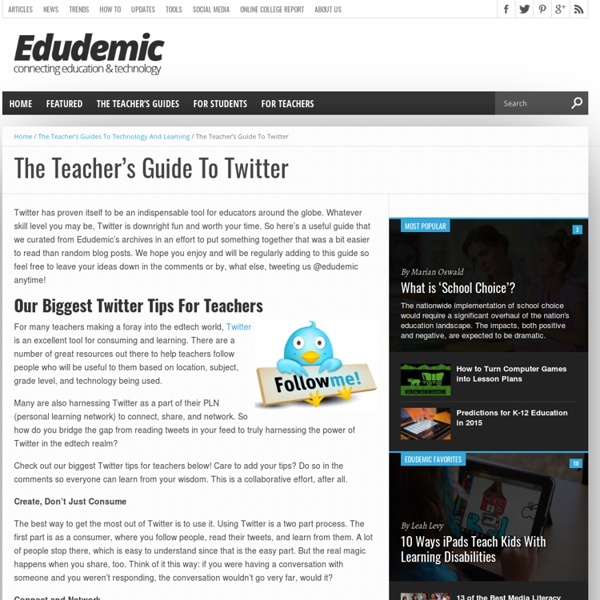The Complete Guide To Twitter Hashtags For Education
What is a hashtag? A word or phrase preceded by a “#.” How do hashtags work? Twitter can be a busy place with lots of tweets–and thus lots of “noise.” A #hashtag is a way to aggregate tweets that are appended with a hashtag. Picture it like a magnet that attracts all messages categorized by that topical word or phrase.
STAR Ideas: Simple, Technology Application Resource Ideas
How can I use technology applications in simple, yet powerful ways? The only software I have on my computer is Microsoft Office, how can I use this in my classroom? How can I create simple, motivating activities that will engage my students in learning? Photo libraries such as CalPhotos, the NOAA Photo Library and American Memories Collection Finder provide wonderful resources for student projects.
Using Twitter for Teachers' Professional Development
I am actually engaged in an extensive review of the literature written on the use of Twitter as a Personal Learning Network ( PLN ).Twitter is the core topic of my MAEd thesis and I am trying to approach it from different perspectives : academic, social, and even personal ( for professional development ). Academically speaking, papers investigating the use of Twitter in the world of academia are still scarce and the empirical research done in this field is still very limited. From time to time I feature some of the resources I am actually reading and which I know will be of great interest to my readers here in Educational Technology and Mobile Learning.For instance, today I am sharing with you a treasure trove ( I really mean it ) of Twitter lists to subscribe with and follow to stay updated about the latest news, resources, links, researches, and many more according to your area of interest.
How to Use Padlet in the Classroom: A Fantastic Teaching Tool
Padlet is a versatile, easy to use tool for every teacher’s toolkit. Let’s learn the basics. At the bottom of this post, I have a Padlet that is temporarily open for you to post and share your favorite edtech tools.
The Busy Person's Guide to Content Curation: A 3-Step Process
Museums curate works of art. We digital marketers curate blog posts. Though our link shares may not be artistic contributions, the idea of curation is at least the same at museums and online: We’re all seeking only the best material to pass along to our patrons, customers, fans, or followers. Finding and sharing exquisite content has never had more value than it does today.
New Google Classroom Features Designed to Help Teachers Differentiate Learning
New updates to Google Classroom are designed to further help teachers differentiate learning through a slew of new individualized learning tools. The updates, Google said in a blog post, were inspired by ways teachers were already using the tool to tailor instruction for the different learners in their respective classrooms. "We know that one-size-fits-all teaching doesn't always meet students' needs, and we've been impressed with the workarounds Classroom teachers have found to differentiate their instruction," Google said. One such update includes allowing teachers to share assignments such as extra practice with individual students as opposed to the whole class.
The Professional Power of Twitter by @Tim_Jumpclarke
Selling the benefits of using twitter for professional development purposes to the uninitiated can be a challenge, but in this re-blog post, Tim Clarke points out some of the benefits he has gained from interacting with the platform, as well as guidance and tips to get colleagues started. Tim is a primary head teacher. The professional power of Twitter
Teaching With Glogster: Using Virtual Posters in the Classroom
Grades 3 – 5 | Lesson Plan | Standard Lesson A Musical Prompt: Postcards From the Concert Students won't miss a beat in this musical lesson that combines listening with personal response on a postcard. Grades 3 – 6 | Lesson Plan | Standard Lesson Color My World: Expanding Meaning Potential through Media Using different writing/drawing materials (e.g., markers, color pencils, pastels, etc.), students learn how to communicate different moods and/or feelings to support their written ideas and how authors do the same through their work.



